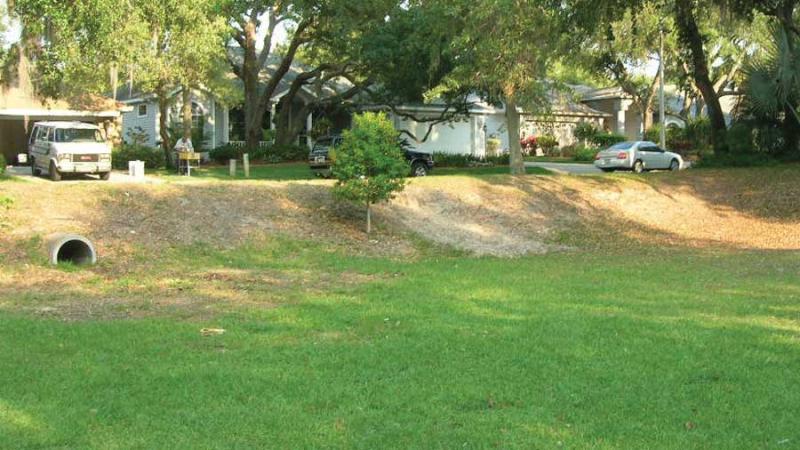Stormwater Systems
A stormwater system is designed to collect and manage runoff from rainwater. They are specifically designed to help prevent flooding and remove pollutants from the water, and they are required for most new development since the 1980s. When rainwater lands on rooftops, parking lots, streets, driveways and other hard surfaces, the rainfall that doesn’t soak into the ground is called stormwater runoff. Stormwater runoff carries pollutants such as litter, motor oil, gasoline, fertilizers, pesticides, pet wastes, sediments and more. Protecting natural waterbodies from these pollutants is important. There's many tips individuals can follow to help, and communities can help too through proper maintenance of their stormwater systems. Learn more below.
Types of Stormwater Systems
Stormwater systems come in a variety of shapes, sizes and forms, and because most systems were designed to imitate natural processes, residents may have stormwater systems on or near their property without realizing it. There are two main types of stormwater systems — retention and detention systems.
Retention System

A retention system is designed to allow water to seep through soil into the shallow groundwater aquifer. A system can be constructed or it can be a natural depression. Grass stabilizes basin slopes and filters sediments. Retention systems are constructed so that stormwater percolates into the ground without direct discharge to natural surface water bodies.
Detention System

Detention systems (ponds) are the most recognizable stormwater system. They are designed to allow material to settle and be absorbed. After a storm, water slowly drains from the pond through a pipe in the “outflow” structure. Part of the pond, known as the permanent pool, is always below the level of the drain structure. Constructed detention systems (ponds) are required to have aquatic plants around the perimeter to help filter sediment in stormwater runoff. The owner of the pond should refer to their permit for exact specifications.
Swale

A swale is a linear retention system, such as a ditch. It is either a constructed or natural area shaped to allow water to be quickly absorbed into the ground or to allow the water to flow to other water bodies. As in a shallow ditch, a swale promotes water absorption through soils. Swales hold water during and immediately after a storm but are generally dry.
Responsibility for Stormwater Systems
In Florida, the responsibility for permitting most stormwater systems rests with the water management districts. After developers complete construction of permitted systems in residential areas, the permit and the legal responsibility for maintaining these systems are typically passed to homeowners, condominium owners or property owners association.
The upkeep and maintenance of the system becomes the responsibility of the association, not the developer or water management district. The association is responsible for labor and expenses for keeping the system functional. This responsibility applies to every homeowner and property owner in the neighborhood, even if they do not live adjacent to a detention or retention system, as everyone’s stormwater flows into the system.
Copies of an association’s operation and maintenance permit, plans and maintenance guidelines should be provided to the association’s representative at the time of transfer.
Stormwater System Maintenance
If properly maintained, stormwater ponds help prevent flooding and filter out pollutants before they reach streams, rivers, lakes, wetlands, estuaries and, ultimately, the gulf. Below are a few basic maintenance guidelines that can help keep stormwater systems functioning properly:
- Clear or clean inflow/outflow structures.
- Remove nuisance and excess vegetation.
- Repair eroded slopes.
- Clean up trash and yard waste in your yard and gutters and around storm drains.
How Can Residents Reduce Water Pollution?
Residents can help improve the quality of water that enters stormwater systems by following a few simple tips. The less pollutants and runoff entering a stormwater system, the less chances of pollutants making it into nearby natural waterbodies.
- Follow our Fertilizing 101 best practices for your lawn.
- Use nontoxic chemical alternatives whenever possible and pull weeds by hand.
- Avoid overuse of fertilizers, especially near the water’s edge.
- The University of Florida’s Institute of Food and Agricultural Sciences recommends using fertilizers with a high percentage of slow-release nitrogen. The higher percentage of slow-release, the less chance of leaching into Florida’s water bodies.
- Use only herbicides labeled for aquatic use when maintaining stormwater ponds.
- Wait until grass is actively growing to apply fertilizer.
- If fertilizer is spilled on the lawn or on the sidewalk or pavement, sweep it up as thoroughly as possible and put it back in the bag.
- Never dump oils and other chemicals from your home directly into stormwater drains.
- Keep vehicles in good operating condition and check for drips and repair leaks immediately to keep nuisance oils off pavement.
- Buy low- or no-phosphate cleaners and detergents. Phosphates act as a fertilizer and increase algae and aquatic weeds in stormwater ponds.
- Wash your vehicles, bicycles and home equipment with nontoxic, low-phosphate soap and use water sparingly.
- Sweep walks and driveways instead of hosing them down.
- Clean up pet wastes to avoid nutrients and bacteria from entering the stormwater drains and contaminate the water system.
- Avoid cutting your lawn too short, which reduces its effectiveness in capturing runoff. Leaving grass taller will also help it to survive dry periods.
- Never deposit lawn clippings in water bodies and storm drains as this can increase oxygen demand in the water, which can significantly harm fish populations. Use lawn clippings for mulch or compost.
- Do not fill stormwater ponds, swales or retention systems. Stormwater systems are designed and constructed to an appropriate size and any reduction in treatment volume will interfere with the pond’s ability to hold stormwater runoff.
- Changing the elevation of large pieces of property can have drastic impacts on where stormwater flows. Consult the stipulations of your neighborhood’s permit before any construction.

